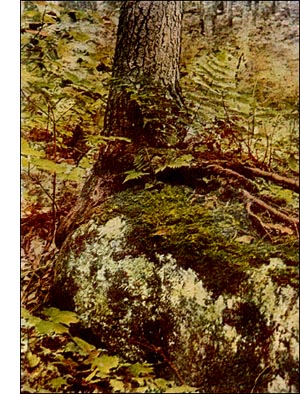Grimmia Apocarpa Moss
 Grimmia apocarpa, Hedw.
Grimmia apocarpa, Hedw.Habit and habitat.-Loosely tufted to form olive-green or black tufts on rocks or stone walls or even on roofs. There are varieties which grow in streams.
Name.-The specific name apocarpa from the Greek for; without and; a fruit, was given by J. G. Hedwig, in 1787, to describe the hidden spore-case.
Plant (gametophyte).-Robust, the stems one inch long, branching in pairs, free from root-like fibres.
Leaves.-Lance-shaped, open when moist, erect when dry; apex sometimes slightly toothed, the upper leaves usually prolonged into a short, rough hair About one-quarter as long as the leaf; the base is concave, becoming keeled upward; margin recurved; the vein continued into the transparent hair, or vanishing below the apex; cells, the basal rectangular, then narrow, the upper rounded.
Leaves at the base of the pedicel ( perichaetial leaves).-Broader, thinner; vein narrow; apex with or without short point.
Habit of flowering.-Male and female flowers on separate part of the same plant (autoicous); mile flower-clusters bud-like.
Veil (calyptra).-Very small, not reaching below the lid, lobed at the base.
Spore-case.-Egg-shaped, almost concealed in the leaves at the base, red.
Pedicel.-Very short.
Lid (operculum).-Bright-red, tipped with a sharp point; columella attached to the lid and falling with it.
Annulus -None.
Teeth (peristome).-Arising below the mouth, large, purplered, entire or perforated, spreading when dry.
Spores.--Mature in winter.
Distribution.-Universal.